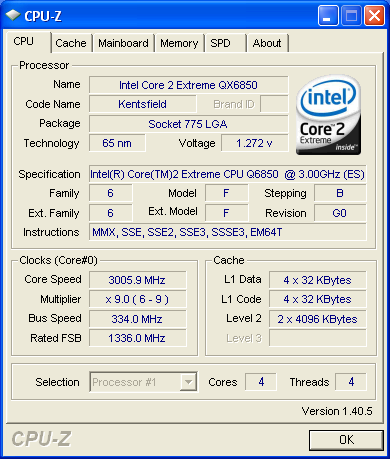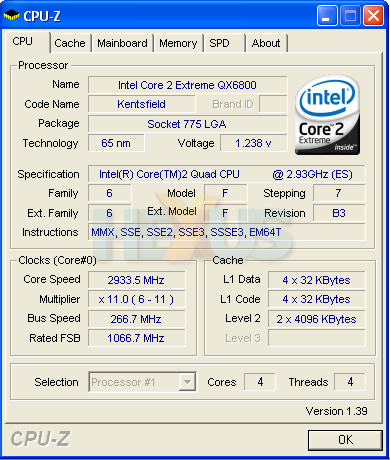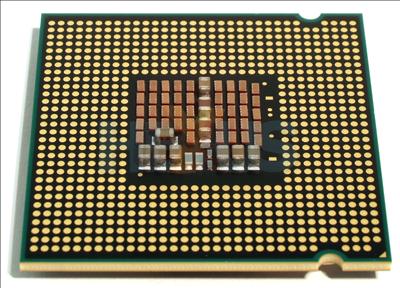QX6850 - pictures and specifications
The Core 2 Extreme QX6850 is still based on the Kentsfield processor core, so those hoping for parts based on the Penryn-derived 45nm quad-core Yorkfield are going to be disappointed.
Compared to the QX6800, the QX6850's multiplier has been lowered, from 11x to 9x, and the front-side bus-speed increased - from 266MHz (1066MHz QDR) to 333MHz (1333MHz QDR). This sees the overall clock speed increase very slightly from 2.93GHz to around 3GHz.
As with previous Kentsfield processors, the QX6850 is still a dual-die, or Multi-Chip Module, implementation. This means that under the heatspreader are two separate pieces of silicon, each a distinct Conroe core.
As a result, Intel can anticipate relatively high yields - a significant benefit. Each core is smaller than it would be if the two were combined in a single piece of silicon, so defects on a wafer will affect fewer complete processors than would otherwise be the case.
In addition, the separation means that it's possible to more finely sort working parts according to speed than would be the case with a single piece of silicon.
For the record, pairing up two Conroes capable of running at 3GHz from 65W creates a 3GHz Kentsfield that fits the 130W power-envelope.
But there are downsides to this strategy, rather than using a native quad-core implementation. Any communication between these separated cores must traverse the front-side bus, something that won't be an issue with AMD's Barcelona and Phenom processors.
But this doesn't seem to affect Kentsfield too badly - and the increased speed of the front-side bus speed should help improve performance in applications where this would be an issue.
| Processor name | Intel Core 2 Extreme QX6850 | Intel Core 2 Extreme QX6800 | AMD Athlon 64 X2 6000+ | AMD Athlon 64 X2 5600+ | AMD Athlon 64 X2 5200+ |
|---|---|---|---|---|---|
| Form factor | LGA775 | LGA775 | AM2 | AM2 | AM2 |
| Manufacturing process | 65nm | 65nm | 90nm | 90nm | 90nm |
| Physical cores | 4 | 4 | 2 | 2 | 2 |
| Inst. per clock | 4 | 4 | 3 | 3 | 3 |
| Pipeline stages | 14 | 14 | 12 | 12 | 12 |
| Clock speed | 3GHz | 2.93GHz | 3.0GHz | 2.8GHz | 2.6GHz |
| FSB | 333MHz (1333MHz QDR) | 266MHz (1066MHz QDR) | 200MHz | 200MHz | 200MHz |
| Memory support | DDR2/3, 800MHz, 1066MHz, DC | DDR2/3, 800MHz, 1066MHz, DC | DDR2, 800MHz, DC | DDR2, 800MHz, DC | DDR2, 800MHz, DC |
| L1 cache total | 128KiB data + 128KiB code | 128KiB data + 128KiB code | 128KiB data + 128KiB code | 128KiB data + 128KiB code | 128KiB data + 128KiB code |
| L2 cache total | 8MiB | 8MiB | 2MiB | 2MiB | 2MiB |
| ISA | x86, x86-64, SSE-SSSE3 | x86, x86-64, SSE-SSSE3 | x86, x86-64, SSE-SSE3 | x86, x86-64, SSE-SSE3 | x86, x86-64, SSE-SSE3 |
| TDP | 130W | 130W | 125W | 89W | 65/89W |
| Transistors | 582m | 582m | 227m | 227m | 227m |
| Operating voltage | 1.2-1.3625V | 1.2-1.3625V | 1.3-1.4V | 1.3-1.4V | 1.3-1.4V |
| Current price | £600 | £728 | £108 | £95 | £85 |
Intel will be keeping up the pressure on AMD over pricing, not just performance - the Core 2 Extreme QX6850 should be pitched lower than the current price of the QX6800 and price cuts across the range are scheduled for July 22.
Until AMD can bring its Phenom X4 parts to market, the company won't have any single-socket CPUs that compete directly with Intel's quad-core Core 2 Extreme offerings.
On
the top of the CPU,
it's business as usual. As our chip is an
engineering sample, there are no real clues as to the model, unless you
happen to be very good at memorising Q-spec codes.
Underneath, the capacitor
layout appears identical to that of the
previous Core 2 Extreme QX6800.


So
beyond the new clock speed, multiplier and bus
speed, things are pretty much the same. Or are they?
No. Like recent Conroe parts, the QX6850 is based on a new G0 stepping, rather than the B3 that's been with us since Kentsfield's launch.
What this actually changes, though, is unclear. Intel's publicly-available technical documents have not yet been updated to acknowledge the existence of this new stepping.











